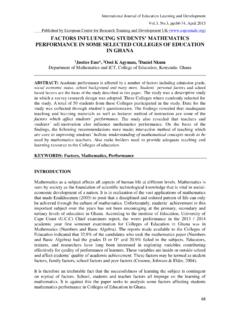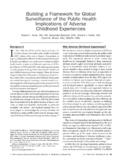Transcription of Intestinal Parasitic Infection among ... - IOSR Journals
1 IOSR journal of Dental and Medical Sciences (IOSR-JDMS) e-ISSN: 2279-0853, p-ISSN: 13, Issue 7 Ver. IV (July. 2014 ), PP 96-101 96 | Page Intestinal Parasitic Infection among Primary School Pupils in Osogbo Nigeria. 1*Oyeniran O. A., 2 Ojurongbe O., 3 Oladipo ,3 Afolabi ,4 Ajayi 5 Oloke 1 Department of Medical Microbiology & Parasitology, Ladoke Akintola University of Technology Teaching Hospital, 5000, Osogbo, Osun State, Nigeria. 2 Department of Medical Microbiology & Parasitology, College of Health Sciences,Ladoke Akintola University of Technology, 5000, Osogbo, Osun State, Nigeria. 3 Department of Pure and Applied Biology (Microbiology/ Virology Unit), Ladoke Akintola University of Technology, 4000, Ogbomoso, Oyo State, Nigeria. 4 Department of Biological Sciences Joseph Ayo Babalola University Ikeji-Arakeji, Osun State, Nigeria 5 Department of Histopathology, Ladoke Akintola University of Technology Teaching Hospital, PMB 5000, Osogbo, Osun State, Nigeria.
2 Abstract: Parasitic infestation caused by Intestinal parasites continues to take their roll on mankind. The symptoms commonly associated with Parasitic infestation can be severe, acute or chronic. The prevalence of Intestinal Parasitic infestation was carried out over a period of three months ( January to March 2008) among 505 primary school children between 6-12 years of age in AUD Primary School A and B Sabo, St. Michael School A and B Ago-wande and Adenle Primary School Ayetoro in Olorunda Local Government with headquarter in smear was used for analyzing faecalsamples for the parasites. Diagnosis was based on identification of the characteristic protozoan cysts and helminthes ova with a compound microscope. The prevalence for Ascarislumbricoides, Entamoebahistolytica,Hookworm, Trichuristrichuria were , and between the male and female showed a significant different in both sexes ( P< ).
3 The percentage prevalence ofAscarislumbricoides was high in between 6-7years and 12 years. No specific age relationship was established for other Intestinal parasites among the pupils. From the findings of this study, it is hereby recommended that deworming and health education should necessarily be a component of the primary health care programme with a focus on school study showed low standard of sanitation among the pupils. Keywords: Ascaris,Entamoeba,Trichuris, Infections, Osogbo, Parasites, Pupils. I. Introduction Parasitic infestations are common in Nigeria especially in rural areas. One fact is that these infections have been associated with low standard of sanitation and between 500 million and 1 billion people are estimated to be infected annually worldwide (WHO,1992; Taiwo and Agbolade,2000; Adeyeba and Akinlabi,2002). It is recognized that certain factors play important roles which include: the strain and number of the parasites, age and level of immunity at the time of infestation, immune responses to the infestations,presence of co-existing diseases or conditions which reduce immune responses, malnutritional undertone due to iron deficiency, folic acid and protein deficiency.
4 This could occur singly or in combination with other causative agents (McGregoret al., 1996). Intestinal parasites are parasites that populate the gastro- Intestinal tract. In humans, they are often spread by poor hygiene related to faeces, contact with animals or poorly cooked food containing parasites. The major groups of parasites include protozoans (organisms having only one cell) and Parasitic worms (Helminthes) of these, Protozoans, including Cryptosporidium, Micrsporidium and Isospora are most common in HIV-infected persons. Other are Entamoebahistolytica, Balatidium coli,Giardia lambliaetc, each of these parasites can infect the digestive tract, and sometimes two or more can cause Infection at the same time. Human Intestinal helminthic parasites are worms that inhabit the body lumens of the gut (Agboladeet al., 2004), they are among the most common Infection occurring throughout the developing world.
5 Intestinal parasites are regarded as important public health problem in tropical Africa (Odutanet al.,1974).These parasites are amongst the most prevalent human infections affecting approximately one quarter of the world s populations, mainly school children due to their poor hygienic nature or poor sanitary conditions coupled with their voracious eating habits( WHO,2002). Parasites can get into the intestine through the mouth from uncooked or unwashed food, contaminated water or hands or by skin contact with larva Infection soil. People can also become infected with Intestinal Intestinal Parasitic Infection among Primary School Pupils in Osogbo Nigeria. 97 | Page parasites if they have mouth contact with the genital or rectal area of a sexual partner who is infected ( oral sex or anal-oral contact). When the organisms are swallowed, they move into the intestine, where they reproduce and cause disease.
6 In some people, Intestinal parasites do not cause any symptoms or the symptoms may come and go. Common signs and complaints include coughing, cramping, abdominal pain, bloating, flatulence and diarrhea. In more serious diminished sex drive, skin-itching, fever, nausea, vomiting or bloody stools may occur. Some parasites also cause low red blood count (anemia) and some travel from the lungs to the Intestinal or vice versa and other parts of the body. Therefore, laboratory test are necessary to determine their cause. However, because many Parasitic infections especially those of helminthes origin are usually asymptomatic or produce only mild symptoms, they are often neglected until serious complications or chronic clinical pictures appear (WHO,2002).The presence of these parasites in asymptomatic carriers has been a major source of Infection to susceptible hosts, hence compounding the problem.
7 In endemic countries, gastro- Intestinal infections are most prevalent in rural communities, peri-urban settings and urban slims (Fashyiet al., 1999). Although, Intestinal parasites could be considered as major problem in rural settlements in Nigeria due to their poor socio-economic status and lack of basic amenities such as water, toilets facilities etc. the problems of these infections are also increasing in the urban areas due to similar deficiencies. In Nigeria, many intervention schemes which were attempted to control these infections did not yield much successes, many are still heavily infected particularly children (Ijagbone and Olagunju,2006). In view of the negative socio-economic impact of these Parasitic infections on infected humans, efforts would be made to elucidate their epidemiological state among pupils. Therefore the study was carried out to know the prevalence and types of Intestinal parasites Infection among the children, the intensity of Infection and to draw the attention of the local authority to the rate of Infection so as to eradicate the problem among the children.
8 II. Materials and Methods Study Group The prevalence of Intestinal parasite was carried out over a period of three months ( January to March 2008) among 505 primary school children between 6-12 years of age in AUD Primary School A and B Sabo, St. Michael School A and B Ago-wande and Adenle Primary School Ayetoro in Olorunda Local Government with headquarter in Osogbo. Stool Collection About 10g of Stool samples were collected into clean wide mouth specimen bottled randomly from all the 505 children. The examination was made without delay (within 24 hours of passage of the stool). The method used to diagnose Intestinal helminthiasis was light microscopy (Jeffrey and Leach, 1975). Macroscopy Examination of Stool Samples. Freshly voided stool samples were examined for bloody, colour, consistency and mucus. Direct Feacal Smear Direct smear were used for analysis of the faecalsamples for parasites.
9 Diagnosis was based on identification of the characteristic protozoan cysts and helminthes ova with a compound microscope using x10 and x40 objectives (Cheesbrough,1992). Formol Ether Concentration Method. The feacal samples that are negative for direct smear were washed prior the concentration procedure. Saline and iodine preparation were made from the deposit on a clean grease free slide and examined for cysts and helminth ova with a compound microscope using x10 and x40 objectives. Data Analysis. The percentage prevalence was calculated as: Prevalence (%) = No of pupils infected x 100% ------------------------------------- Total number of pupils examined. Data analysis was done using chi-square X2 and student T test to test the level of significant between variables. Intestinal Parasitic Infection among Primary School Pupils in Osogbo Nigeria.
10 98 | Page III. Results A total of 505 freshly voided stool samples were collected between the ages of 6 to 12 years, which consists of 275 males and 230 females from three primary schools in Osogbo metropolis. Out of the total samples, 373 ( ) were infected, 216 ( ) male and 147 ( ) females were infected. Table 1 shows the prevalence of Intestinal helminthes Infection according to gender, being higher in male than in females. Table2reveals the prevalence rate ofAscarislumbricoides( ), hookworm ( ), Entamoebahistolytica( ), Trichuristrichuria( ) andEntamoebacoli ( ) which is non-pathogenic in Infection of AscarislumbricoidesandEntamoebahistolyti cawas recorded among 31 ( ) and Ascarislumbricoides and Hookworm ( ) in the study. The student t test analysis of the Parasitic Infection between the males and females showed a significant difference between the sexes (P< ) The percentage prevalence of Ascarislumbricoides was high in pupils between 12 years of age and progressively decreased in pupils between 8-9 years.
















